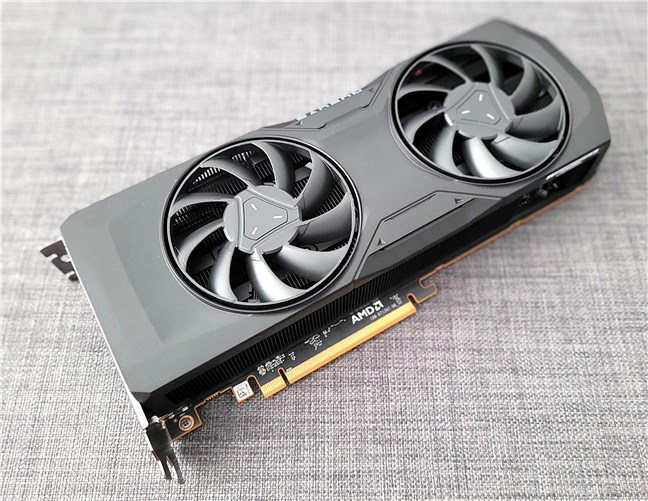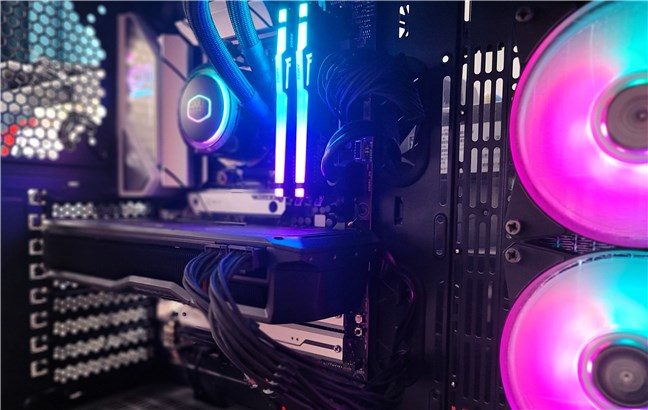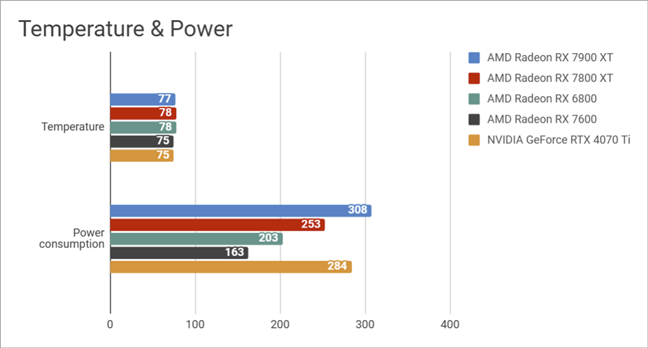
In recent days, AMD Radeon RX 7800 XT grabbed the headlines due to some leaked benchmarks that showed it outperforms NVIDIA’s GeForce RTX 4070. That’s great news, considering AMD’s card launches at a slightly lower price than NVIDIA’s RTX 4070. Some said that it might be able to challenge even the more expensive GeForce RTX 4070 Ti. All this sounds great, but are these rumors true? I just finished testing it, and I have plenty of data to share with you. If you’re building a new PC or upgrading your old one, read this review for the AMD Radeon RX 7800 XT:
AMD Radeon RX 7800 XT: Who is it good for?
You should take the AMD Radeon RX 7800 XT graphics card into account if you want:
- To play games on high graphics quality in 1440p resolutions
- A significant upgrade from a previous-gen AMD or NVIDIA GPU
- A graphics card with a good performance per price ratio
Pros and cons
There are plenty of good things to say about the AMD Radeon RX 7800 XT:
- Excellent gaming performance in 1440p resolutions
- Generous amount of memory and high bandwidth
- Efficient cooling system
- Standard 8-pin power connectors, which means you don’t need special cables
- Faster and more capable DisplayPort 2.1 outputs so you’re ready for the future
When it comes to weaknesses:
- Ray-tracing performance is decent but behind NVIDIA’s
- Power consumption is a bit high

Verdict
The AMD Radeon RX 7800 XT is a mid to high-end graphics card that’s optimized for gaming in 1440p resolutions. Its performance, in this case, is excellent, the card offering high framerates in most games, even if you’re choosing to play your favorite game on high or ultra visual settings. 4K gaming is doable, but you’ll have to lower the graphics quality and, something I strongly recommend, enable AMD’s FSR upscaling tech. Considering its price-per-performance ratio, the Radeon RX 7800 XT has the chance to become a popular choice in the coming shopping season. Overall, the AMD Radeon RX 7800 XT is a great choice for both gamers and content creators who want performance at a reasonable price (549 EURO vs 559 EURO for the competing GeForce RTX 4070).
Unboxing the AMD Radeon RX 7800 XT
Following the same design principles we’ve seen for the other AMD Radeon RX 7000 graphics cards, the box of the 7800 XT looks great. At a glance, you can tell that the card is painted black (with shades of gray), with a small red accent on the radiator, that its cooling system includes two fans, and that it needs two 8-pin power connectors. While the front side of the box is definitely minimalistic (only showing the name of the card and a picture of it), it says more than you’d expect. 🙂

The box of the AMD Radeon RX 7800 XT
The technical information on the back of the box is also scarce: you only get to see a few details about the AMD Adrenalin Software, the stability, performance, and experiences offered by the Radeon RX 7800 XT. When unboxing the Radeon RX 7800 XT, you can marvel at how good the graphics card looks.

Unboxing the AMD Radeon RX 7800 XT
Besides the Radeon RX 7800 XT, the box also contains a quick start guide and a card that’s welcoming you to the Red Team.

AMD Radeon RX 7800 XT: What's inside the box
As is the case with all the other Radeon RX 7000 cards, the unboxing experience offered by the AMD Radeon RX 7800 XT is straightforward and minimalistic.
Design and hardware specifications
The Radeon RX 7800 XT is built on the AMD RDNA 3 architecture, the same one used for all the cards in the RX 7000 series. Counting 28.1 billion transistors, the graphics processing unit features a Navi 32 GCD (Graphics Compute Die) and four MCDs (Memory Cache Dies). The GCD, which is the core of the card responsible for all complex calculations, is manufactured using a 5nm process. The MCDs are created using a 6nm manufacturing process, and their role is to provide links to the GDDR6 video memory and cache.

AMD's Radeon RX 7800 XT is built on the RDNA 3 architecture
There are 60 compute units, 60 ray accelerators, 120 AI accelerators, and 3840 stream processors found on this GPU. Except for the number of AI accelerators, the others are the same as the ones offered by the previous generation Radeon RX 6800 card. Although you may think that the RX 7800 XT should be the successor of the RX 6800 XT, it looks like its real predecessor is the RX 6800. Although some numbers look the same, performance is improved on the 7800 XT thanks to other changes like higher clocks and faster memory. Take the clocks, for instance: the Radeon RX 7800 XT features a game GPU clock of 2124 MHZ and a boost GPU clock that can reach 2430 MHz. They are significantly higher frequencies compared to the 1815 MHz game clock and 2105 MHz boost clock offered by the Radeon RX 6800.

AMD Radeon RX 7800 XT tech specs
Furthermore, the card benefits from 64 MB of 2nd generation AMD Infinity Cache and 16 GB of GDDR6 with a speed of 19.5 Gbps. Paired with a 256-bit memory bus, the card’s effective memory bandwidth can theoretically reach 2708.4 GB/s, which is 1044.2 GB/s more than you got from the Radeon RX 6800 (1664.2 GB/s).

AMD Radeon RX 7800 XT has 16 GB of memory
AMD’s Radeon RX 7800 XT uses a PCI Express 4.0 x16 interface and offers support for DirectX 12 Ultimate. As you’ve certainly noticed, the card also comes with 60 ray accelerators, which should offer a decent gaming experience even in games with ray tracing (more details later, in the benchmarks section of this review). If you can’t get at least 60 frames per second in your favorite game and absolutely want ray tracing enabled, the good news is that you can always use AMD’s upscaling tech - FidelityFX Super Resolution 2 (FSR 2) - to boost the framerate. There are over 300 games right now that support AMD FSR, out of which at least 150 are compatible with AMD FSR 2. Oh, and by the way, games that will support the next-generation AMD FSR 3.0 are just around the corner. 🙂
[DC-TEX2-AD]
Having gone through the essential tech specs, let’s now take a look at how the AMD Radeon RX 7800 XT is designed physically. With a length of 267 mm (10.52 inches) and occupying 2.5 slots vertically, the card is and looks massive. Though not as huge as a Radeon RX 7900 XTX or XT, it’s still large. Theoretically, it should fit in any standard-size desktop computer case.

The AMD Radeon RX 7800 XT occupies 2.5 slots
To continue, the design of the AMD Radeon RX 7800 XT reference card is similar to that of the other RX 7000 GPUs. The only striking difference compared to the enthusiast-level RX 7900 XTX and XT is that the RX 7800 XT has two fans instead of three.

The AMD Radeon RX 7800 XT uses two fans
Otherwise, the graphics card has no RGB lights, and black is the color of the day. 🙂 Also, a nice-looking metallic backplate covers the card, protecting it from unwanted damage (bending) as well as helping with thermal dissipation.

The metal backplate of the AMD Radeon RX 7800 XT
Unlike any of the competition’s cards, the AMD Radeon RX 7800 XT features support for DisplayPort 2.1, which (theoretically) allows for a maximum refresh rate of up to 900 Hz in 1440p resolution, 480 Hz in 4K, and 165 Hz in 8K. The reference card includes three such outputs plus an HDMI 2.1 port.

Ports on the AMD Radeon RX 7800 XT
In terms of power specs, the AMD Radeon RX 7800 XT draws its additional power via two standard 8-pin PCIe connectors and can draw up to 263 Watts. AMD recommends a power supply unit (PSU) with a minimum of 700W. That’s a bit higher than the previous-gen AMD Radeon RX 6800’s consumption of 250W. It’s also significantly more than what this card’s direct competitor - NVIDIA GeForce RTX 4070 - requires, which is 200W.

AMD Radeon RX 7800 XT can draw up to 263W
Looking over its specifications, the AMD Radeon RX 7800 XT appears to be a mid to high-end graphics card that should deliver impressive performance and features for both gamers and content creators. As far as gaming goes, it looks like this card is specifically targeted at 1440p resolutions.
These are the main aspects regarding the technical specifications and design of this graphics card. If you want even more details about it, you should visit AMD’s official webpage: AMD Radeon RX 7800 XT Tech Specs.
AMD Radeon RX 7800 XT - Gaming benchmarks
Specifications and technical numbers don’t portray the whole picture. While they can give us an idea of how good a graphics card is, the percentage increases in clocks, memory amount, and whatnot don’t necessarily translate into similar performance boosts. That’s why, to get a clear idea of how powerful the AMD Radeon RX 7800 XT graphics card is, I’ve also tested it in a couple of games and synthetic benchmarks. For this purpose, the desktop computer I used had the following hardware and software components:
- Motherboard: ASUS Prime X670E-Pro WiFi
- Processor: AMD Ryzen 9 7900X
- CPU cooler: Cooler Master MasterLiquid ML360R RGB
- Memory: Kingston Fury Beast RGB DDR5-6000 32GB
- Storage: Kingston KC3000 NVMe PCIe 4.0 SSD 2TB
- Monitor: ASUS ROG Strix XG32UQ
- Power Supply Unit: ASUS ROG Thor 850W Platinum
- Operating System: Windows 11 Pro version 22H2

The desktop PC used for benchmarks
In addition to that, in the next charts, I’ve also included the results I got using other GPUs that I’ve previously tested:
- AMD Radeon RX 7900 XT - the enthusiast-level card that’s right above the 7800 XT in the RX 7000-series lineup;
- AMD Radeon RX 6800 - the predecessor of the 7800 XT from the previous-gen AMD Radeons (this is the reference card that I’m directly comparing to the Radeon RX 7800 XT, in order to see the generational performance leap);
- AMD Radeon RX 7600 - the most affordable option from the current generation of Radeon graphics cards;
- ASUS TUF Gaming NVIDIA GeForce RTX 4070 Ti OC Edition - a more expensive option from NVIDIA (unfortunately, I didn’t have the chance to test any RTX 4070 GPU, which is the direct competition for the Radeon RX 7800 XT)
Also, before moving on to the benchmark results, keep in mind that I’ve tested all the games using the highest possible graphics settings (ultra) without enabling FSR on the AMD cards or DLSS on the NVIDIA sample.
The first game I benchmarked was CyberPunk 2077. Its system requirements are extremely high if you want to play it on maxed graphics settings. On the Ray Tracing Ultra preset, the AMD Radeon RX 7800 XT managed to render an average of 43 fps (frames per second) in 1080p resolution and 27 fps in 1440p, which translates into a 30% and 28.57% increase, respectively, compared to what I got with its Radeon RX 6800 predecessor. In 4K, the 13 fps I got is a clear indication that you need to lower the graphics quality significantly and use upscaling to get past the 60 fps limit for decent gameplay.

Benchmark results in Cyberpunk 2077
I continued with The Callisto Protocol. This horror survival game also comes with some steep requirements in terms of graphics card performance. With the game set to use its Ultra graphics preset and ray-tracing effects enabled (high), I got 90 fps in 1080p and 70 fps in 1440p. That’s a huge performance increase (28.57% in 1080p and 40% in 1440p) compared to the RX 6800. Results in 4K were excellent too (39 fps), but in this case, I’d go with enabling AMD FSR to get over 60 frames per second.

Benchmark results in The Callisto Protocol
The third game I tested was The Witcher 3: Wild Hunt Next-Gen Update. I believe most gamers out there can testify that this is one of the best games of all time. Unfortunately, for this latest update, you need a powerful system if you intend to (re)play it on the highest graphics quality. With the RT Ultra graphics preset enabled, I got an average of 48 fps in 1080p and 34 fps in 1440p. These results translate into a performance increase of 36 - 37% compared to the Radeon RX 6800, which is quite significant. For this game, though, I’d say skip 4K resolutions (17 fps average as measured) unless you’re OK with decreasing the graphics quality settings by a lot.

Benchmark results in The Witcher 3 Wild Hunt Next-Gen Update
Next, I went on to test Total War WARHAMMER III, a turn-based strategy and real-time tactics title that looks great even if it doesn’t feature ray-tracing effects. Using the Ultra graphics preset, the AMD Radeon RX 7800 XT rendered 145 frames per second in 1080p, 96 in 1440p, and 49 fps in 4K. These results average an increase in performance of about 21% compared to the Radeon RX 6800 in all three resolutions. It’s an excellent generational leap if you ask me.

Benchmark results in Total War WARHAMMER III
Next on my list of games to test was Assassin’s Creed Valhalla, which still looks amazing today. Although it has no ray-tracing effects, it still demands a lot of graphics performance to run at maxed visual quality. The AMD Radeon RX 7800 XT was able to deliver remarkable results in all the resolutions tested: 155 fps in 1080p, 120 fps in 1440p, and 68 fps in 4K. Just like in the previous title, these numbers translate into a performance increase of over 20% compared to the previous-gen RX 6800, regardless of the resolution used.

Benchmark results in Assassin's Creed Valhalla
The penultimate game I tested was Resident Evil Village. Though rather old, this game still requires powerful hardware to enjoy its visuals to the fullest. Once more, I had a beautiful surprise, as the AMD Radeon RX 7800 XT had no issues whatsoever in running this game at a framerate that easily went over 60 fps, even in 4K. Taking the Radeon RX 6800 predecessor as the starting point, the performance increase is 21% in 1080p, 27% in 1440p, and 22% in 4K.

Benchmark results in Resident Evil Village
F1 22 was the last game I benchmarked. The Ultra High graphics preset available comes with ray-tracing effects, which, as you know, demand a lot of performance from the GPU. The Radeon RX 7800 XT handled the 1080p and 1440p resolutions exceptionally, but it struggled a bit in 4K. However, the performance you get compared to the RX 6800 falls between 19 to 23% increases.

Benchmark results in F1 22
With the game tests over, I continued running a few synthetic benchmarks from 3DMark. I ran Time Spy Extreme to see the graphics card’s performance in DirectX 12 gaming, Speed Way to check the performance in games that use DirectX 12 Ultimate, and Port Royal to get an even better idea of how the Radeon RX 7800 XT handles ray tracing. In all three benchmarks, the scores obtained by the AMD Radeon RX 7800 XT were excellent. In Time Spy Extreme, which is the only test that doesn’t include ray tracing, the performance increase compared to the RX 6800 was about 11%. In the other two, Speed Way and Port Royal, which come with ray-tracing effects, the increase was even more significant, roughly 20%.

Benchmark results in 3DMark
Last but not least, I also kept an eye on the maximum temperature and power consumption of the AMD Radeon RX 7800 XT. While running the previous benchmarks and also during a test with Furmark, the card reached a maximum temperature of 78 degrees Celsius (172.4 Fahrenheit), in line with most other modern GPUs. As for the maximum power draw, the highest value I saw was 253 Watts, which is significantly more than what its forerunner demanded: almost 25% more than the maximum power consumed by the Radeon RX 6800. Still, it’s a fairly decent number for a graphics card this powerful.

Maximum temperature and power consumption
The benchmarks results show that the AMD Radeon RX 7800 XT is a mid to high-end graphics card destined for those who want to play games at maxed settings in 1440p resolution. Its performance is excellent in this case (in 1080p too, evidently), and with the help of AMD FSR upscaling tech, you can max graphics quality even in very demanding games with lots of ray-tracing effects. Depending on the game, you can go even further to 4K, albeit with some “discounts” to your graphics quality settings.
What’s your opinion about the AMD Radeon RX 7800 XT?
Now you know that the AMD Radeon RX 7800 XT is a great choice if you’re looking for a mid to high-end graphics card that can handle the latest games. What’s your opinion about it? Are you considering buying it? What are your reasons for wanting it? Do you believe it’s a better deal than NVIDIA’s options in this price range? Let me know in the comments section below, and if you want to read more of our reviews, don’t hesitate to subscribe to our newsletter.


 06.09.2023
06.09.2023 


